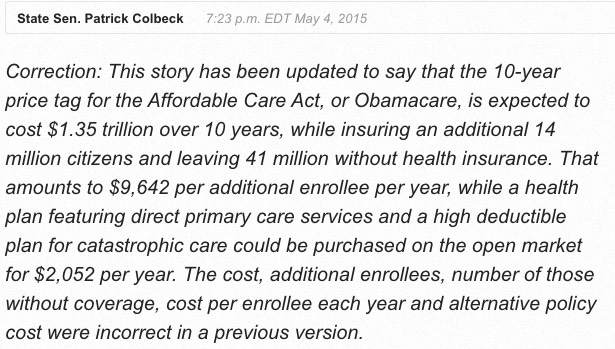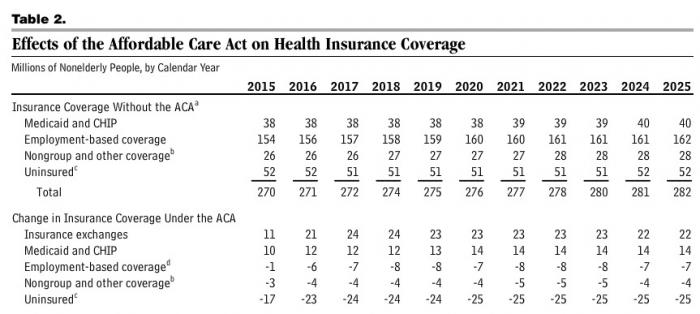Michigan: Gee, I guess I owe Pat Colbeck an apology*; the ACA cost-per-enrollee may *not* be $5,000 apiece...
...it could actually be several hundred dollars lower.
A week ago I posted a story in which I busted Michigan State Senator Patrick Colbeck for blatantly spewing nonsense numbers about the ACA in an Op-Ed in the Detroit News.
Yesterday, my follow-up story, about the Detroit News allowing Colbeck to go back in and correct some (but not all) of his insanely false factual garbage a solid 10 days later (while failing to give any indication about just how absurdly wrong he had been in the first place) went viral, generating more visitors than any other story I've posted in months.
After an all-day saga, the end result was that the Detroit News finally posted a "correction" notice...except they did so in such a disingenous way (and so long after the original editorial was publshed) as to be nearly meaningless.

So, that's the end of the story, right?
Well, mostly...but there's one more loose end I need to clear up, regarding one of my own numbers from yesterday. In Colbeck's original version, he claimed that the cost of the Affordable Care Act was a ridiculous $1.35 trillion per year to insure "an additional 19 million citizens". His $1.35T number was obviously insane (it was based on the CBO's report from January, but covers an ELEVEN year period, not a single year, and not even my own 10 year correction! You have to divide it by 11 to get not $135 billion, but just $123 billion per year.
Even then, however, the CBO issued an updated report back in March which further reduced the cost to just $1.207 trillion from 2015 - 2025. In my post I divide by 10 years to get $121 billion per year...but it turns out I should have divided by eleven years instead, for just $110 billion per year!
In other words, as I noted, Colbeck was still overstating the most reliable estimate of the ACA's cost...but instead of still overstating it by 12%, he was actually still over by nearly 23%!!
OK, so that's the numerator: The actual cost is estimated to be just 8% as much as Colbeck originally stated, 81% of his corrected version...and even 9% less than my own correction!
OK, that's a bit embarrassing, I admit.
However, I found the denominator (19 million additional people) to be even more curious, since it was actually higher than either the my own estimate of the net reduction to date in the uninsured since the ACA exchanges were launched (14 million) or even the 16.4 million figure that the HHS Dept. is claiming since the ACA was signed into law. For the life of me, I couldn't figure out a) where Colbeck came up with the 19 million figure or b) why he would deliberately use it instead of the lower figure touted by the Obama administration itself.
In my response, I noted that according to Glenn Kessler, fact checker for the Washington Post, the actual per-enrollee cost is more along the lines of $5,000/year apiece at most regardless of what method you use.
In Colbeck's "corrected" version, he changes his insane $71,052/enrollee claim to the far more reasonable $9,642/apiece...but as I noted yesterday, that's still a good 93% too high.
In the comments section, a rather rude commenter asked an admittedly reasonable question: If you divide $135 billion into 14 million, you do get $9,642...and even if you use the revised $121 billion, that's still over $8,500 apiece, which is closer to $9,642 than $5,000...so what gives?
Well, first of all, the further-corrected cost estimate shows that dividing $110B by 14M actually equals $7,857. However, neither Colbeck nor I realized this error until now, so I guess I can't fault them for that one.
Setting that aside, however, there's two parts to the answer. First, that $1.207 trillion is made up of amounts which change over time. It's not exactly $110 (or $121) billion each and every year for 11 years straight; here's the table in question:

As you can see, the CBO currently projects the net cost of ACA coverage provisions to be a mere $74 billion this year, rising each year over the next decade until it hits around $135 billion in 2025, at which point it appears to pretty much stabilize. Add that up and you get $1.207 trillion over 11 years, or $110 billion per year.
HOWEVER, it's the second part of the answer which is more important (and also explains the discrepancy between his 19M and my 14M figures). Take a look at the next table:

When you combine the ACA exchange enrollment as well as Medicaid enrollees, the CBO currently projects the 2015 reduction in the uninsured to be roughly 17 million people. So where did Colbeck's 19 million come from? Well, in the CBO's previous report back in January, they had this number a couple million higher...at 19 million.
OK, so fine: They've knocked this down to 17 million more recently. This is still higher than my own 14 million...because that's what I estimate the net reduction in the uninsured to be currently. By the end of 2015 this should be reduced further (barring a King v. Burwell disaster, of course), mostly via Medicaid expansion. I don't know if it'll be 17 million, but it should be higher than 14 by then.
Still, I'm willing to give Colbeck this one; I'm the one who gave the lower number (which actually strengthens his claims, after all), so fair enough: 14 million for 2015 it is.
Here's the thing, though: If you're going to use the estimated 11-year average cost, you also have to use the estimated 11-year average reduction in the uninsured...and that's where the table above comes in.
Yes, the CBO now projects that 17 million more people will be insured thanks to the ACA in 2015. However, they also project this to go up to 23 million next year, 24 million in 2017, eventually plateauing at 25 million after that. Guess what the average is? 23.8 million people per year.
Divide $110 billion (avg.) by 23.8 million (avg.) and you get just $4,622 per person, per year, for 11 years.
Of course, you could also argue that Colbeck was only referring to 2015; we have no idea what will happen next year! Given the impending King v. Burwell decision, that's a fair point. So instead, let's just go with the 2015 numbers:
Divide $74 billion (for 2015 only) by 17 million and you get $4,353.
Of course, I did just offer my own 14 million estimate as a "gimme"; in that case, dividing $74B by 14M would equal $5,285...except that if 3 million fewer people are insured via the exchanges and/or Medicaid than the CBO expects (14M instead of 17M), that also means that the cost in subsidies/Medicaid spending will be considerably lower than expected as well. 3M / 17M = about 17%; reducing $74B by 17% would yield a 2015 cost of around $61 billion. Divide that by 14 million and you get...$4,357 per person.
In other words, just as the WaPo's Kessler put it:
No matter how you slice it, the cost per newly insured person is less than $5,000 a year.
There. I hope that straightens things up.
Still, I hereby apologize* for overstating the CBO's estimated annual cost by about 10%, while underestimating the CBO's estimated enrollment gain by up to 17%...but something tells me Sen. Colbeck isn't likely to appreciate my corrections very much.
*(that's called snark or sarcasm, people)



